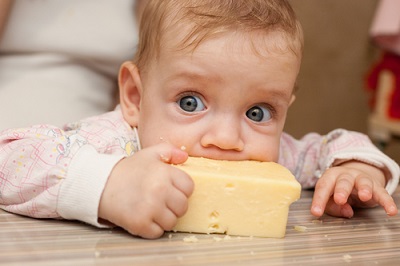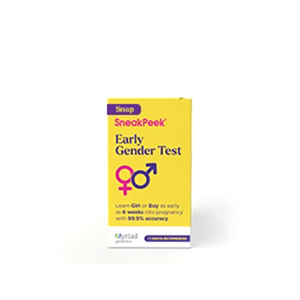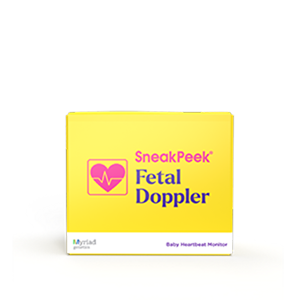Published on February 10th, 2022 and Updated on January 15th, 2024
Check out SneakPeek Gender Test to find out your baby’s gender as early as 6 weeks at over 99% accuracy1!
Transitioning away from breast milk or infant formula is a tremendous developmental milestone, but while you’re trying to serve your little one dishes like mashed banana and pureed peas, she may be trying to serve up something else—fresh chaos.
If you end each mealtime feeling mildly frustrated and majorly covered in baby food, you may begin to wonder when your baby can eat actual solid food (you know, something she can’t smear all over her highchair). Fortunately, we can help.
Want to know when can babies eat cheese?
Since cow’s milk should not be given to babies until they are one year old, other dairy foods such as cheese and yogurt should be considered. To learn more about when you can introduce yogurt, visit our post, “When Can Babies Have Yogurt?” Typically, babies can safely eat cheese around 6 months old. However, your child’s exact timeline will depend on her individual development, and there are a few considerations you may want to keep in mind before pulling out the cheddar. So, let’s get into our guide on all things gooey, melty, and cheesy.
Solid Food Guidelines for Babies
During his first few months, your baby’s menu is strictly breast milk or formula. After all, his jaw muscles are still learning how to work, and he’s missing some crucial solid-food-eating tools (i.e., his teeth).
So, exactly when can babies have cheese and other solid foods?
The Center for Disease Control recommends waiting to serve your baby solid food (including cheese) until he’s at least 6 months old. Any younger, and you risk asphyxiation. However, 6 months is a soft guideline, so before sprinkling a bit of mozzarella on his half-birthday dinner, check for these signs that your baby is ready for solid food:
- He can sit up on his own with minimal support
- He can control his neck and head
- He opens his mouth for food
- He swallows food well (i.e., it doesn’t dribble right back out of his mouth)
- He can grasp small objects
If your baby has reached these benchmarks, congratulations! It’s time to upgrade his menu with solid foods.
Is cheese safe for babies to eat?
Salty, tangy, creamy, sharp—cheese is a pretty amazing food (or food group, for the real enthusiasts). However, when it comes to your baby, dairy products like cheese have a few more risks than your average solid food.
Let’s explore a few factors to consider before putting cheese on your baby’s plate.
Pasteurization
When it comes to cheese (or any dairy product for that matter), experts recommend pasteurized over raw for babies.
Pasteurization, a regulated heating process, eliminates harmful bacteria in food and beverages. For raw dairy, this cuts down the public health risk of food poisoning and disease outbreak. It’s for For this reason, the Food & Drug Administration has made the pasteurization of all milk and milk products mandatory for interstate sale and distribution. However, because individual states still maintain regulatory control over their own milk products, unpasteurized milk and dairy products may still be available in some locations.
In fact, between 1993 and 2012, the Food & Drug Administration reported that unpasteurized dairy led to over 140 hospitalizations and 1,900 cases of illness. For this reason, the American Academy of Pediatrics recommends the following vulnerable groups not eat raw dairy products:
- Babies
- Young children
- Pregnant women
- Elderly adults
- Immunocompromised adults
Some purists argue that raw dairy contains more nutrients than pasteurized products, but that’s not founded in scientific studies. Studies find that raw and pasteurized dairy carry the same levels of vitamins, minerals, and fats. Stick with pasteurized milk and cheese, and you only eliminate risks.
Lactose Intolerance
Lactose is a sugar found in dairy that’s metabolized by the lactase enzyme. Because our human bodies depend on milk for nourishment when we’re first born, lactose intolerance before the age of three is very rare (it can increase over a lifespan as the dependence on milk for sustenance diminishes). Only a tiny percent of kids (about 1 out of 60,000) inherit congenital lactose intolerance from their parents.
If your baby has congenital lactose intolerance, any cheese consumption will cause symptoms such as:
- Watery diarrhea
- Gas and bloating
- Stomach cramping or pain (indicated by fussiness, clenched fists, or an arched back)
If you notice these symptoms after serving your little one cheese, talk to your pediatrician to properly diagnose the condition.
Dairy Allergies
Surprisingly, dairy allergies are not caused by lactose intolerance. Dairy allergies stem from autoimmune reactions rather than a lack of the lactase enzyme and are a slightly more common problem—about 2.5% of kids under 3 years old have a food allergy to dairy.
How do you know if your baby is allergic to dairy? You only really know if they try eating dairy. Luckily, dairy allergies are typically mild and can even fade with time.
But if you notice these symptoms after dairy consumption, keep cheese off the table for the time being, and contact your pediatrician:
- Diarrhea
- Stomach pains
- Eye redness & watering
- Wheezing
- Coughing
- Itchy skin
- Vomiting
How to Choose Cheese for Your Baby
For adults, the cheese plate holds infinite possibilities. For babies… this isn’t exactly the case. By understanding cheese nutrition and types, you can create an infant-friendly cheese plate with safe varieties that emphasize nutrition and flavor.
Cheese Nutrition
No, it’s not exactly broccoli, but cheese does have a few nutritional benefits. For babies, real cheese holds some vital macronutrients, vitamins, and minerals that support growth, including:
- Protein – Since protein plays a key role in muscle growth, it’s an essential part of any baby’s diet. One ounce of hard cheese has up to 8 grams of protein, while one cup of cottage cheese has over 20 grams of protein per cup.
- Fats – For infants in particular, dietary fats (like those found in cheese) improve vitamin absorption, support hormones, and build healthy brains.
- Calcium – When medical professionals discuss dairy, they usually bring up one vital nutrient—calcium. Cheese is a great source of this bone-building mineral, with about 80 to 180 milligrams per one-ounce serving (up to 70% of a baby’s daily calcium value).
- Vitamins A & B12 – Vegetables aren’t the only source of vitamins. Most cheeses offer vitamin A and vitamin B12, essential nutrients that support vision, skin, metabolism, and nerve health.
- Conjugated linoleic acid – Another reason why high-fat cheese reigns supreme? It has conjugated linoleic acid, a molecule that can prevent heart disease, obesity, and inflammation. Leave low-fat blocks on the grocery store shelf to give your baby peak nutrition.
Best Cheese Types for Babies
When picking a cheese for your baby to eat, straddle the three “T’s”—taste, texture, and total nutrition. Although nourishment is key, you need your little one to swallow it willingly first!
The best types of cheese for babies are:
- Soft, shredded, or grated – A shredded, grated, or soft cheese is less of a challenge for your foodie at this early chewing stage. To avoid asphyxiation, avoid cheese chunks, sticks, or cubes.
- Low in sodium – Doctors recommend that infants under 12 months stick to 400 milligrams of sodium per day. Since most cheese ranges from 15 to 400 milligrams per one-ounce serving, it’s important to stay wary of choosing a cheese with excess sodium.
- Mild in taste – Even the most gourmand baby will likely turn away gorgonzola. With their sensitive taste buds, babies typically prefer milder flavors. Think less tang, more creaminess.
- High in nutrients – Not all cheeses are created equal. Some are calcium powerhouses (like parmesan and swiss), while others pack in the protein (like cottage cheese and ricotta). No matter which you choose, know that most natural cheeses beat out processed cheese types in the nutritional boxing ring.
Need a cheat sheet? Here are a few nutritious and delicious cheese options you can add to your next grocery list:
- Soft – Cottage cheese, cream cheese, ricotta, swiss
- Shredded – Mild cheddar, Colby, Monterey Jack, mozzarella
- Grated – Parmesan, romano
Tips for Cheese Introduction
You’ve made a list, checked it twice, and stocked your fridge full of dairy—now what?
Buying baby-friendly cheese is one thing. Getting your little guy or girl to eat it? That’s another. Don’t lose hope, though—we have a few sneaky and simple tips to introduce this delicious snack to a picky eater:
- Start small – Avoid overwhelming your baby and serve just one new food at a time. This means serving cheese on its own or alongside a familiar food. Doing this will also help you recognize if cheese is an allergen for your little guy.
- Spoon-feed – Up until recently, your baby has likely eaten most of his food off a spoon. Starting with spoonable cheeses (like cottage cheese or ricotta) can help him adjust to the new taste and texture.
- Prepare baby-sized bites – When serving spreadable or solid cheeses, give your baby a small piece. Not only are large chunks of cheese a choking hazard, but they’re also more difficult for tiny mouths to chew and swallow.
- Add to a favorite dish – Every mom has an arsenal of vegetable sneak-attacks—blended carrots in tomato sauce, cauliflower tater tots, ground mushrooms in burgers, you get the idea. While cheese might not need the same disguise, pairing it with a favorite dish can help. Sprinkle it over a scrambled egg or serve it with a tortilla for an easy start. To learn more about when you can introduce eggs, visit our post, “When Can Babies Eat Eggs?”
Navigating the world of solid foods for your baby can feel overwhelming, but cheese offers nutritional benefits and a delightful addition to your baby’s evolving menu. Just remember to stick to pasteurized, mild, and low-sodium cheese, always check for allergic reactions, and introduce it in a baby-friendly manner – soon your little one will be able to enjoy the wonderful world of cheese!
Sources:
- CDC. When, What, and How to Introduce Solid Foods. https://www.cdc.gov/nutrition/infantandtoddlernutrition/foods-and-drinks/when-to-introduce-solid-foods.html
- FDA. The Dangers of Raw Milk: Unpasteurized Milk Can Pose a Serious Health Risk. https://www.fda.gov/food/buy-store-serve-safe-food/dangers-raw-milk-unpasteurized-milk-can-pose-serious-health-risk
- Harvard Health. Cheese. https://www.hsph.harvard.edu/nutritionsource/cheese/
- Healthline. Is Cheese Bad For You? https://www.healthline.com/health/is-cheese-bad-for-you
- Healthline. Raw Milk: Do Its Benefits Outweigh the Dangers? https://www.healthline.com/nutrition/drinking-raw-milk
- Healthline. Signs and Symptoms Your Baby May Be Lactose Intolerant. ??https://www.healthline.com/health/baby/lactose-intolerance-symptoms-in-babies
- Healthline. When Can Babies Eat Cheese? https://www.healthline.com/health/baby/baby-cheese#best-cheeses
- KidsHealth. Fats. https://kidshealth.org/en/parents/fat.html
- KidsHealth. Calcium. https://kidshealth.org/en/parents/calcium.html
- Men’s Health Journal. 14 Best High-Protein Cheeses, Ranked. https://www.mensjournal.com/food-drink/best-high-protein-cheeses-ranked/
- NHS UK. What should I do if I think my baby is allergic or intolerant to cows’ milk? https://www.nhs.uk/common-health-questions/childrens-health/what-should-i-do-if-i-think-my-baby-is-allergic-or-intolerant-to-cows-milk/
- What to Expect. Introducing Cheese to Your Baby. https://www.whattoexpect.com/first-year/baby-feeding/when-can-babies-eat-cheese

Shop Our Products
SneakPeek aims to provide the most accurate and up-to-date information to help our readers make informed decisions regarding their health before, during, and after pregnancy. This article was written based upon trusted scientific research studies and/or articles. Credible information sources for this article are cited and hyperlinked.





